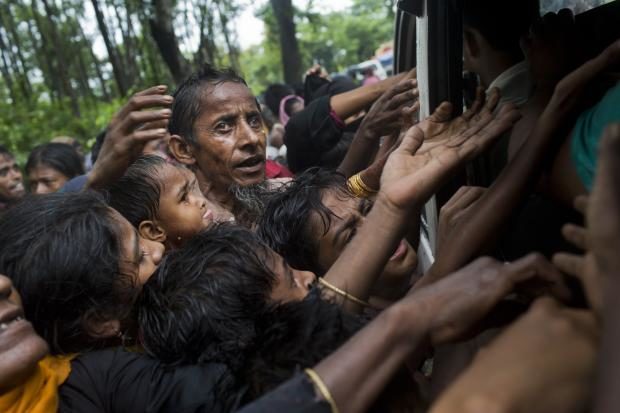
Rohingya scuffle to get aid material from local volunteers at Kutupalong, Bangladesh, Friday, Sept. 8, 2017. The UN said Friday that an “alarming number” of 270,000 Rohingya Muslims have fled violence in Myanmar by crossing into Bangladesh in the last two weeks. (Photo by BERNAT ARMANGUE / AP)
COX’S BAZAR, Bangladesh — With Rohingya refugees still flooding across the border from Myanmar, those packed into camps and makeshift settlements in Bangladesh are becoming desperate for scant basic resources and dwindling supplies.
Fights are erupting over food and water. Women and children are tapping on car windows or tugging at the clothes of passing reporters while rubbing their bellies and begging for food.
The U.N. said Saturday that an estimated 290,000 Rohingya Muslims have arrived in the border district of Cox’s Bazar in just the last two weeks, joining at least 100,000 who were already there after fleeing earlier riots or persecution in Buddhist-majority Myanmar. The number was expected to swell further, with thousands crossing the border on foot each day.
“More and more people are coming,” said UNHCR spokeswoman Vivian Tan. With camps already “more than full,” the new arrivals were setting up spontaneous settlements along roadsides or on any available patches of land.
Within the camps “we are trying our best, but it is very difficult because every day we are seeing new arrivals” with nowhere to go.
Many of the newly arrived were initially stunned and traumatized after fleeing violence that erupted Aug. 25 in Myanmar’s Rakhine state. They are now growing desperate in searching for food distribution points that appeared only in recent days, passing out packets of biscuits and 25-kilogram (55-pound) bags of rice.
One aid worker who asked not to be identified because they were not authorized to speak to the media said “stocks are running out” with the refugees’ needs far greater than what they had imagined. “It is impossible to keep up,” she said.
At one food distribution point, women were volunteering to help keep order by tapping people with bamboo sticks to gently urge them back in line. Weary women carried infants in their arms while clutching other children to their sides, afraid they might be separated in the crowds.
One 40-year-old man, faint with hunger, collapsed while waiting and could not stand again on his own strength when others tried to help him up. They drizzled water between his lips in an attempt to revive him, to no avail.
“Everyone is hungry. Everyone has been waiting for hours,” said another aid worker, who also did not want to be identified by name.
He said the crowds were becoming unmanageable, and that aid agencies may need to ask for a police presence.
“We are not prepared here for such a huge number,” he said.
Refugee camps had already been filled to capacity. Makeshift settlements were quickly appearing and expanding along roadsides, and the city of Cox’s Bazar — built to accommodate only 500,000 — was bursting at its seams.
There was an urgent need for more temporary shelters, Tan said. “We are seeing the mushrooming of these very flimsy shelters that will not be able to house people for too long,” she said.
The U.N. has asked Bangladesh authorities to make more land available so they can build new relief camps.
An increasing number of Rohingya were also arriving by boats that crossed the monsoon-swollen Naf River or the rough waters in the Bay of Bengal. Some 300 boats from Myanmar reached Cox’s Bazar on Wednesday alone, the International Organization for Migration said.
The exodus began Aug. 25 after Rohingya insurgents attacked police posts in northern Rakhine state. The military responded with what it called “clearance operations” to root out any fighters it said might be hiding in villages.
It’s not known how many Rohingya remain in Rakhine state. Previously the population had been thought to be roughly 1 million.
The Myanmar government says nearly 400 people have been killed in fighting it blames on insurgents, though Rohingya say Myanmar troops and Buddhist mobs attacked them and destroyed their villages.
Journalists in Rakhine state saw active fires in areas Rohingya had abandoned, adding to doubts over government claims that Rohingya themselves were responsible for setting them.
Dozens of Rohingya have died in boat capsizings as they fled the violence. Those who trek days through the jungle to cross the land border face other dangers, including land mines. On Monday, the AP saw an elderly woman whose leg had been blown off in a land mine blast.
Land mines were planted years ago along parts of the border. Bangladeshi officials say Myanmar soldiers have planted new explosives since the latest wave of violence began, though the Myanmar military denies it.
“It may not be land mines, but I know there have been isolated cases of Myanmar soldiers planting explosives three to four days ago,” Lt. Col. S.M. Ariful Islam, commanding officer of the Bangladesh border guard in Teknaf, said Friday. He added that he was aware of at least three Rohingya injured in explosions.